BULLETIN OF THE UNITED STATES FISH COMMISSION 1890
Page 73
Report on the Fisheries of the New England States
By J.W. Collins and Hugh M. Smith
I. GENERAL REMARKS AND STATISTICS.
The fisheries of the New England States are so well defined as to their character, methods, etc., and form such an important part of the industrial life of that section, that it is deemed proper to present a special paper dealing with their various phases, in order to exhibit their extent and condition in greater detail than would be practicable if the entire coast of the United States were under consideration.
The information herein given is similar in general scope, character, and arrangement to that contained in the "Statistical Review of the Coast Fisheries of the United States," recently published by the U. S. Fish Commission, but is much more detailed than ever before presented in the matter of minor civil divisions. It is thought that this feature of the paper will be received with favor, since it enables the reader to obtain the fullest statistical information concerning the extent of the fisheries in each coast county in New England. The material upon which the report is based was obtained by a personal canvass by agents of the U. S. Fish Commission of the 3,460 miles of coast line covered by the statistics. The report relates to the calendar year 1889 and includes the entire commiercial fisheries of the New England coast. Under each State will be found a definite statement of the extent to which the various rivers were investigated; in general, however, it may be said that all streams were canvassed to the limits of economic fishing, and the report may therefore be regarded as a complete exposition of the fisheries and fishery industries of this section.
The tables have been compiled and arranged with the purpose of exhibiting the different phases of the fisheries under the following heads:
1. Civil divisions: A clear conception can be obtained of the relation of the fisheries, not only to each State but to each county along its coast.
2. The vessel and shore fisheries: These are exhibited in such a, manner as to show definitely the extent and value of each.
3. The value of fisheries by apparatus: These tables show the relative effectiveness of each form of apparatus as applied to the fisheries.
4. The importance of the fisheries by species: Under this head are considered such fisheries as those prosecuted for the cod, the mackerel, the whale, etc.
Page 73
--------------------------------------------------------------
Page 74 BULLETIN OF THE UNITED STATES FISH COMMISSION.
5. An exhibit of the fisheries by fishing-grounds: These apply more particularly to the food-fish fisheries. The value to the New England fishermen of all the leading fishing-grounds is thoroughly demonstrated by showing the amount of products landed. No feature of this report is of greater importance than that embraced under this heading, since its consideration will show graphically and at a glance the relative importance of these fishing-grounds and will serve as a basis for the consideration of international questions bearing upon the fisheries. It will be seen that the fishing-grounds which are of greatest consequence to our fishermen are those in the open ocean or near our own coast. The grounds in the Gulf of St. Lawrence or in other waters immediately adjacent to Canadian territory are of comparatively minor importance.
6. Special phases of the fisheries, such as the average earnings per ton, per fisherman, per hundred dollars invested capital, etc. This feature, inasmuch as it exhibits at a glance many of the salient points connected with the fisheries and furnishes a basis for comparing the importance of the various branches of the industry in each county, will doubtless prove of interest.
7. The importance of the bait fishery and the relative effectiveness of certain forms of apparatus in procuring bait.
8. The extent of the important shore industries: These include the branches dependent on the fisheries proper, as sardine and lobster canning, herring smoking, etc. A brief explanation of certain features of the tables will contribute to a clearer conception of their scope. In the first place, in order to show clearly in one total the yield of different branches of the fisheries, it has been found necessary to reduce to the common unit of a pound certain products that are not usually handled on such a basis in the trade. In reading the tables, therefore, the following key, which covers all cases, should be borne in mind:
Oysters: The weight given is for the edible part (meats and liquor); 7 pounds to a bushel.
Round clams or quahogs (Venus mercenaria) : Same as oysters; 8 pounds to a
bushel.
Long clams or soft clams (Mya arenaria,) : Same as oysters; 10 pounds to a bushel.
Scallops (Pecten irradians and P. magellanicus): Weight of "eye;" or muscle (the
edible portion) is given; 3 and one half pounds to a bushel.
Oil (whale, seal, and fish) : 7 and one half pounds to a gallon.
Idle vessels, boats, apparatus, and shore property are omitted from the statistics. The boats carried on vessels are not shown separately; their value is included with the outfit of the vessels.
The classification of the fish is into fresh, salted, and smoked. Fish specified as salted are those which leave the vessels or the hands of the fishermen in the various states of preservation by means of salt. The smoked fish shown in the regular tables are only those which are so prepared by the fishermen; the smoking done at canneries and in smokehouses not used by fishermen has been considered to be a manufacturing enterprise and has been included under the head of shore industries. Canned fish are shown only as the products of manufacture and not of fishery. The quantities represent in all cases the weights as sold by the fishernien and, consequently, are considerably less than the weights which the products have when taken from the water.
---------------------------------------------------------------------
Page 75
Thus, the fish classified in the tables as salted would, when round, weigh approximately twice as much as the amount given, and smoked fish lose about two-thirds the weight in the process of curing.
The values of products are in all cases based on the prices paid the fishermen, or the original cost.
The series of special tables for each State, which show in detail (by fisheries and fishing-gronnds) the importance of the vessel fisheries, needs some little explanation. By the arrangement giving the extent of the fisheries by fishing-grounds each vessel is credited to all the fisheries in which it was engaged during any portion of the year, together with its tonnage, value, and crew; it is therefore duplicated to that extent, but no duplication of the catch occurs. The following definitions of the more important fisheries recognized will aid in giving a clear understanding of the tables:
Shore fishery: Vessels engaging in this branch are mostly small craft, about 5 to 50 tons, frequenting waters adjacent to the New England shore and catching so-called ground fish, which are sold either fresh or salted.
Market fishery: Vessels credited to this fishery are of medium or large size and take fish on the banks lying to the westward (Georges, Browns, etc.) or off the New England coast. The catch consists mostly of cod, haddock, pollock, hake, and halibut, and is landed in a fresh condition.
Halibut fishery: Vessels incidentally taking small quantities of halibut in the bank, market, and shore fisheries have not been classed under the halibut fishery, which designation has been reserved for vessels making special trips for that species and landing their fares in a fresh condition or fletched and salted. The other species taken while fishing for halibut are properly credited to this fishery.
Mackerel fishery: All vessels taking the common mackerel, with seines, hooks, or gill nets, are shown under this head. Alewives, menhaden, herring, shad, swordfish, and other species taken, in purse seines or by any other means, while catching mackerel are included in this fishery.
The other fisheries are self-explanatory.
In order that no misunderstanding may arise from the use of common or popular
names in this paper, it is considered advisable to present in this place the scientific
identifications opposite the common names.
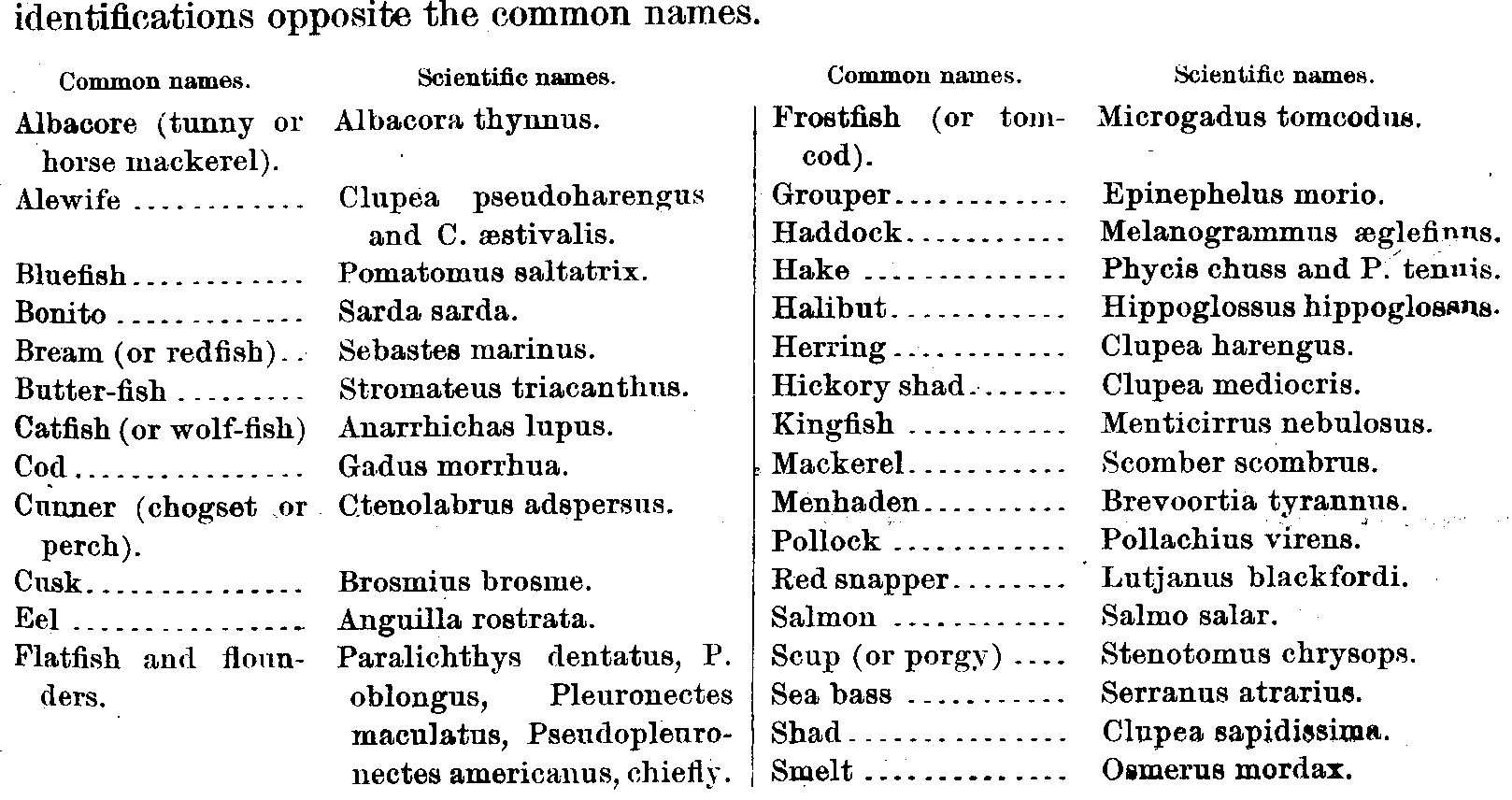
---------------------------------------------------------------------------------------
PAGE 76 . BULLETIN OF THE UNITED STATES FISH COMMISSION.
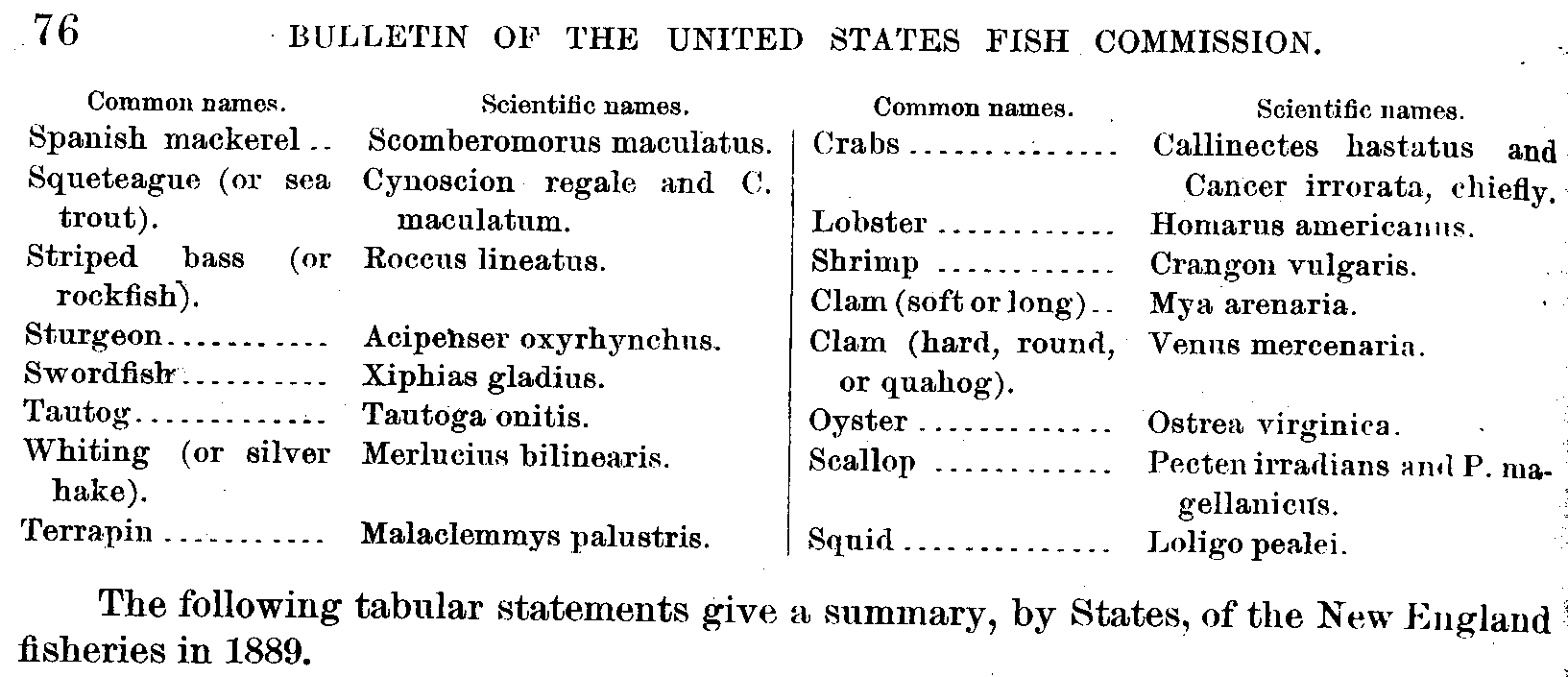
The following tabular statements give a summary, by States, of the New England fisheries in 1889.
The first table shows that 36,536 persons were employed in the industry, of whom 15,122 were engaged in the vessel fisheries, 12,295 in the shore or boat fisheries, and 9,119 in various capacities onshore. In the number of vessel fishermen Massachusetts is much in the lead of all the other States, having 10,851 persons in this class. Maine takes first rank in the shore fisheries and shore industries, giving employment to 6,205 and 5,244 persons, respectively.
The vessels, boats, apparatus, shore property, and cash capital employed in the New England fisheries are next given. The table shows 1,542 vessels, with a tonnage of 79,738.49, valued, with their outfit, at $6,382,006. Massachusetts is credited with more than half of all the fishing vessels of New England, viz, 836, followed by Maine with 408, Connecticut with 214, Rhode Island with 69, and New Hampshire with 15.
Of the 11,561 boats, valued at $657,010, used in the shore fisheries, Maine has 5,990, worth $237,469, and Massachusetts has 3,494, valued at $254,033. The apparatus employed in the actual taking of fish and other products was valued at $1,683,525, of which $692,638 represented trawl and hand lines, $442,960 weirs, pound nets, and trap nets, $190,276 pots, $183,220 seines, $104,309 gill nets, and $68,122 minor forms, including bag nets, fyke nets, harpoons, spears, dredges, tongs, rakes, etc. Of the total investment in apparatus of capture, Massachusetts has $1,009,621, Maine $423,564, Rhode Island $119,417, Connecticut $106,682, and New Hampshire $22,291. The capital invested in shore property of various kinds, as wharves, buildings, flake yards, etc., amounted to $5,850,979, of which more than half is to be credited to Massachusetts.
The amount of ready money required to properly conduct the fisheries, and known as cash capital or working capital, was $5,523,224, Massachusetts employing $4,284,200. The total investment in vessels, boats, apparatus, shore property, and cash capital amounted to $20,094,794, of which Massachusetts had $13,245,229, Maine 982,889,893, Connecticut $2,826,834, Rhode Island $1,020,178, and New Hampshire $112,660.
The third table shows the quantity and value of each species of fish and other marine products taken in each State. It is seen that, considering the New England States together, the cod is by far the most important species, being valued at 2,539,757, after which come oysters at $1,399,784, lobsters at $833,736, whale products at $828,463, haddock at $738,732, mackerel at $731,424, halibut at $725,756, and menhaden at $428,228. Regarding the quantities of products, menhaden rank first, with 173,632,210 pounds, followed by seaweed, with 149,553,900 pounds; cod, with 97,145,645 pounds; haddock, with 43,473,627 pounds; herring, with 36,316,259 pounds, and lobsters, with 30,449,603 pounds.
--------------------------------------------------------------------------------------------
Page 77
The largest catch was made by the Massachusetts fishermen, who took 299,217,669 pounds, valued at $5,858,274. Maine ranks second, with 129,559,864 pounds, $2,111,206, followed by Rhode Island, with 127,365,475 pounds, $935,144; Connecticut, with 92,672,464 pounds, $1,557,506, and New Hampshire, with 4,354,568 pounds, $88,511. The combined catch of all the New England States was 653,170,040 pounds, worth $10,550,641.
Table 1 showing the number of persons employed in the fisheries of the New England Slates in 1889.
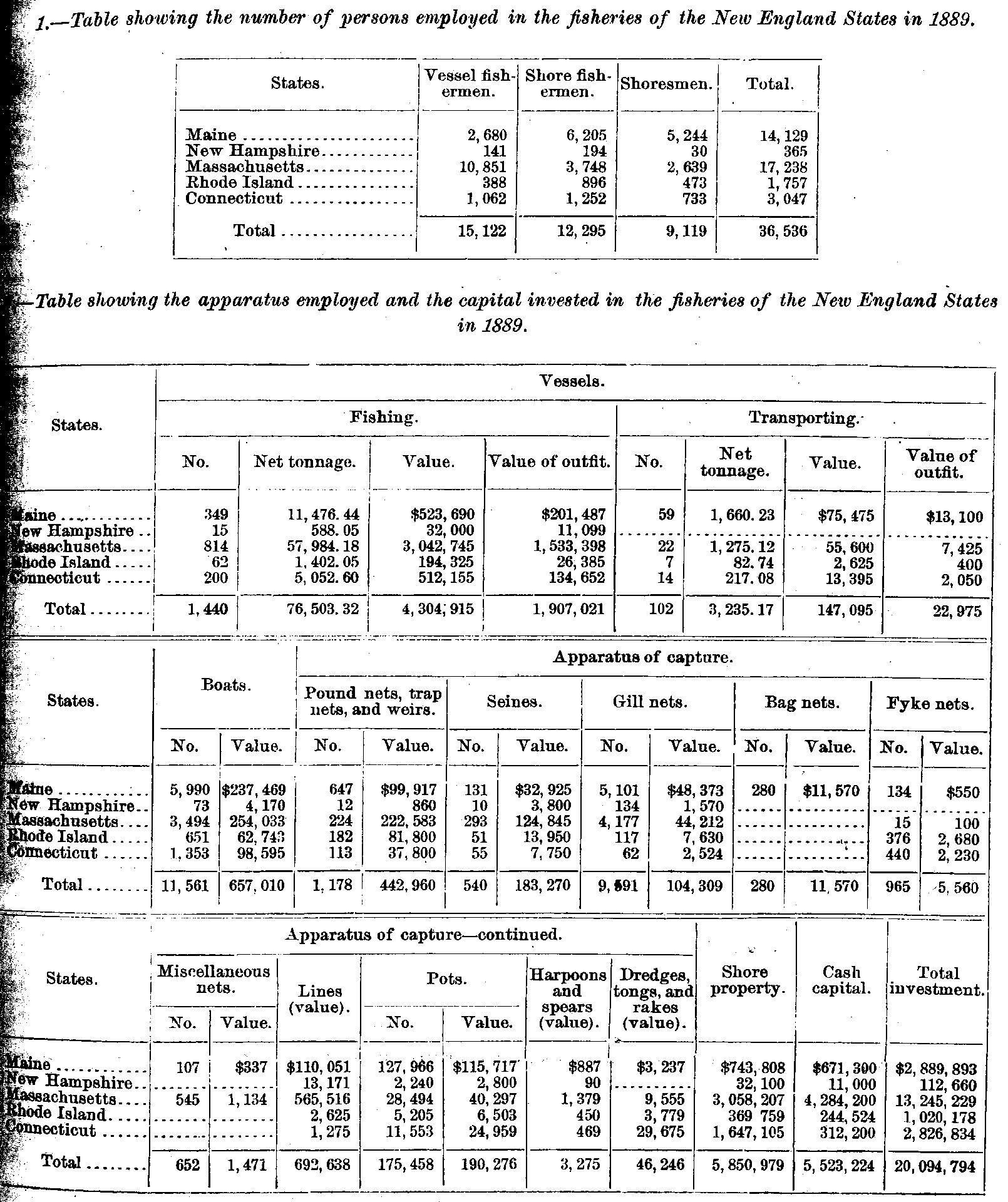
Table2 showing the apparatus employed and the capital invested in the fiaheriea of the New England States
in 1889.
--------------------------------------------------------------------------------------------
Page 78
Table showing by species the yield of the Fisheries of the New England States in 1889
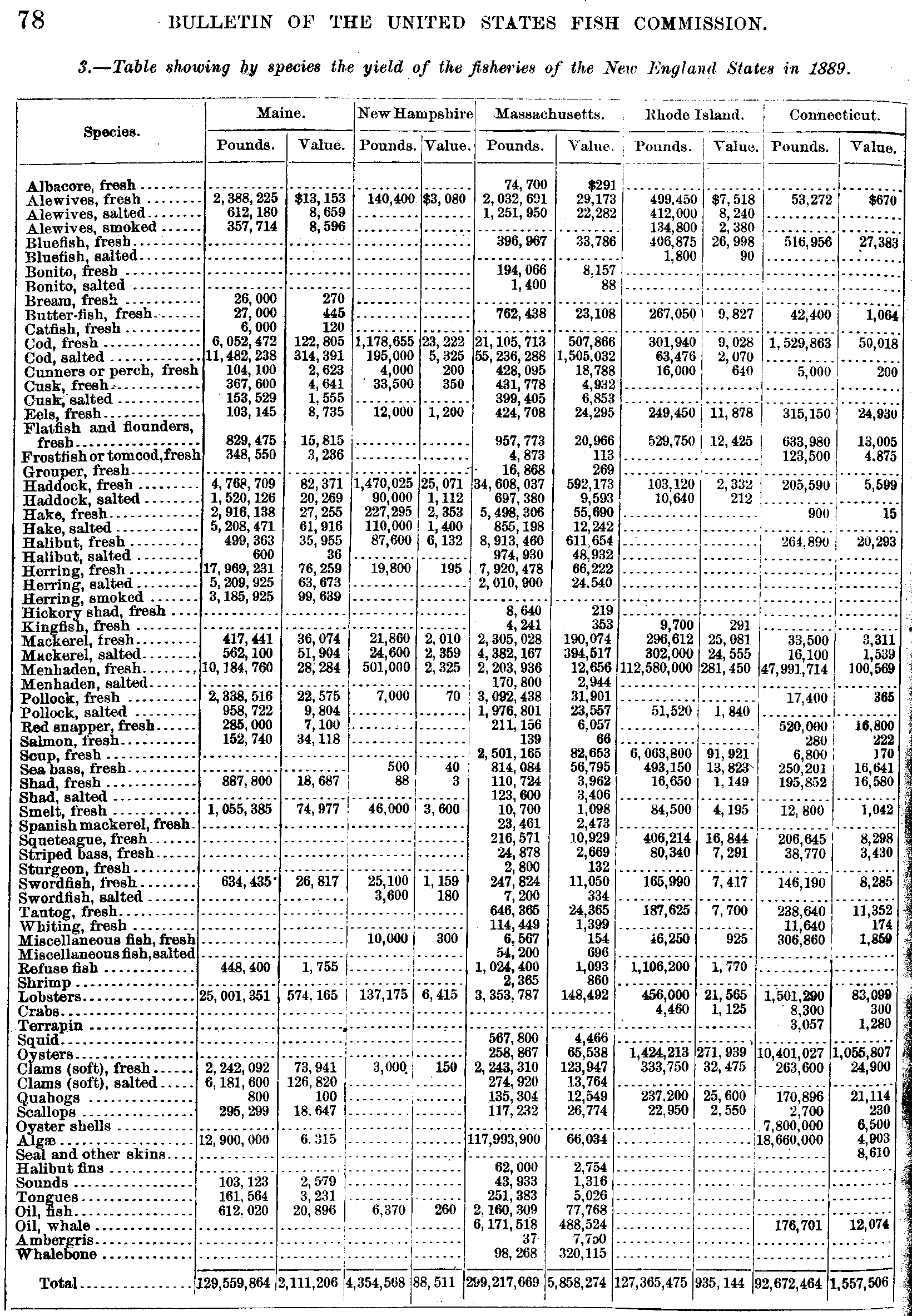
=========================================================
Page 79
FISHERIES OF THE NEW ENGLAND STATES.
Table 3 showing by species the yield of the fisheries of the New England States in 1889
SUMMARY.
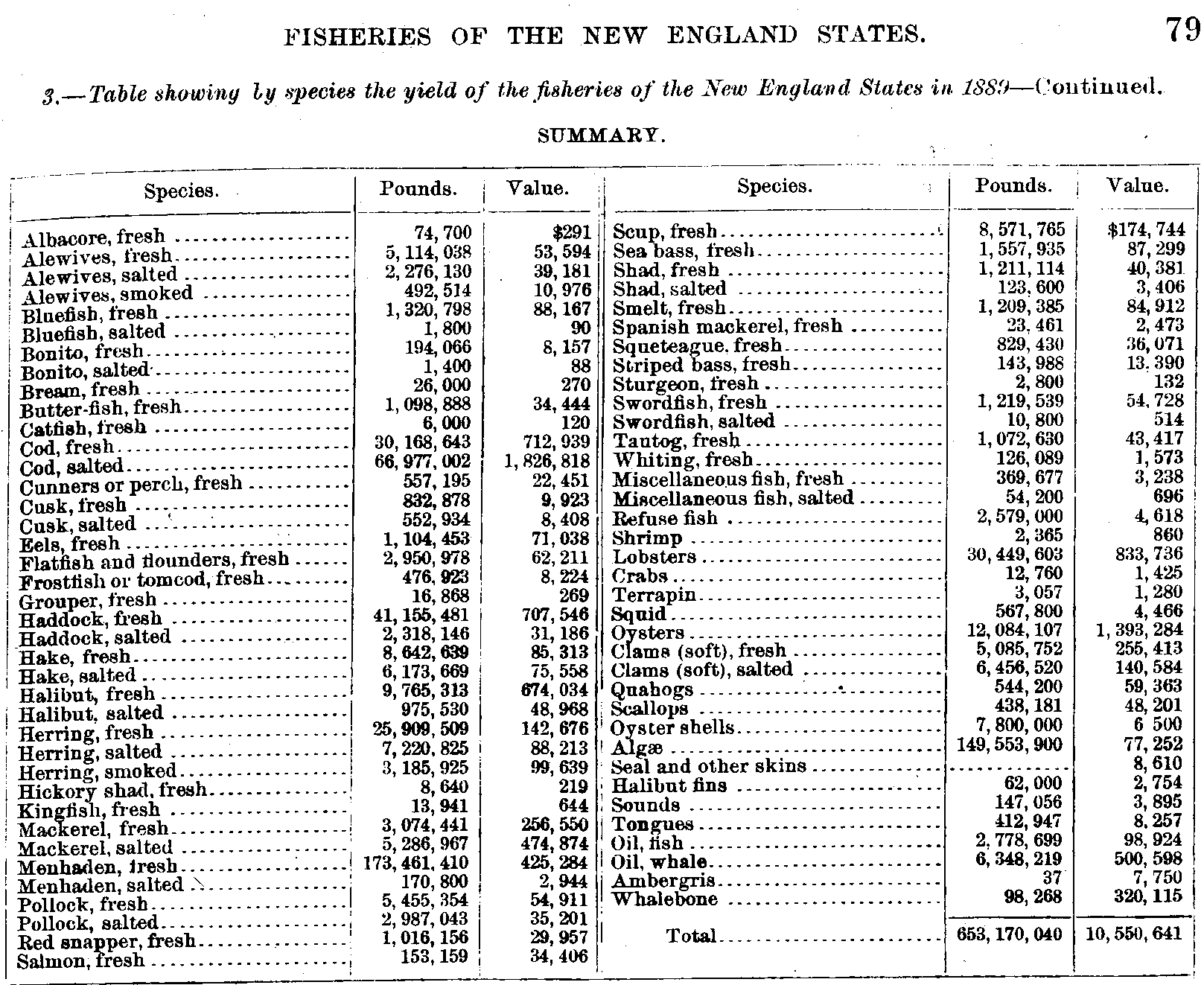
The question of the nationality of the persons constituting the crews of American fishing vessels is one of marked consequence, in view of the dependence to be placed on the fishery marine of New England in the event of war. The following table gives an accurate idea of the extent to which the citizens of foreign countries were represented in the vessel fisheries of the New England States in 1889. The figures show that Americans constitute 78.30 per cent of the fishermen, while British provincials compose 9.52 per cent and all other nationalities 12.18 per cent.
4. Table 4 showing the number and nationality of persons employed in the vessel fisheries of the New England States in 1889.

Fishing Vessels. Nothing connected with the development of the New England fisheries is more worthy of notice than the improvements recently made in the form and rig of sea-going fishing vessels. The change has been most noticeable, perhaps, in Massachusetts. A few years ago the New England fleet was composed of wide, sharp, shallow schooners, remarkable for having very broad sterns and flat counters. As a
----------------------------------------------------------------------------------------------------------
Page 80
BULLETIN OF THE UNITED STATES FISH COMMISSION.
rule they were heavily rigged, and were extremely unsafe in the severe gales to which they were frequently exposed. Many foundered at sea, going down with all their crews, and the loss of life and property was often appalling. The very general belief that this type of vessel was the best for speed led to its general adoption, speed being an important factor in nearly all of the ocean fisheries.
As early, however, as 1882 the U. S. Fish Commission called attention to the faults of this form and rig of fishing vessels, and a change was vigorously urged through the publication of letters in the newspapers printed in fishing towns.
Later, in 1886, the Fish Commission schooner Grampus was built on new lines. She was a marked innovation on the prevailing ideas concerning the building of fishing vessels, being deeper, and also less broad and flat in her after section. It is to the credit of those interested to say that they soon saw the advantage of having safer and swifter vessels, and since the date last mentioned the most radical changes have occurred in form and rig. The very best talent has been brought to the work of de- signing fishing craft, and it is safe to assume that at present no other country has a fleet of sailing fishing vessels so swift or so beautiful as those recently turned out from the shipyards of New England, while their seaworthiness has been correspondingly improved.
Already the old type is rapidly being superseded by the new, and the change will probably be quite complete in a few years in those branches of fishery where speed and seaworthiness are specially important factors. As a result, not only will there be a marked reduction in loss of life and property by vessels foundering at sea, but the fisheries will be vastly benefited by having vessels so much swifter than those formerly employed.
Mention may appropriately be made of the introduction of the cutter rig on small craft. Until recently the schooner rig has been practically universal north of Cape Cod, but within the past three or four years a few vessels of about 15 or 18 tons have been rigged as cutters or sloops with what is commonly called a double-head rig. These craft have been built on fine lines, and have in some cases been so swift that yachts have been copied after them.
The number and tonnage of the vessels of different rigs employed in the fisheries of each New England State are shown in the next table, the vessels fishing and those transporting being given separately. The special facts disclosed by the table are:
(1) the great preponderance of the schooner in the New England States as a whole, and especially in Maine, Massachusetts, and New Hampshire; (2) the employment of ships, barks, and brigs only in the fisheries of Massachusetts; (3) the relatively large number of steam vessels in Connecticut and Rhode Island, and (4) the restriction of the cat rig to Massachusetts and Rhode Island. The proportion of each rig is as fol- lows: Schooners, 78.21 per cent; sloops, 11.09 per cent; steamers, 5.71 per cent; barks, 2.46 per cent; cats, 1.95 per cent; ships, 0.32 per cent, and brigs, 0.26 per cent. The square-rigged vessels are all employed in the whale fishery, the steamers chiefly in the rnenhaden and oyster industries; sloops have always been in more general favor in Connecticut than elsewhere; the cat-rigged vessels are small, generally only a little more than 6 tons each, and what are commonly called boats. The almost universal adoption of the schooner rig for fishing purposes is well known and emphasizes its fitness for American waters.
------------------------------------------------------------------------------------------
Page 81
FISHERIES OF THE NEW ENGLAND STATES.
Table 5 showing by States and rigs the number and tonnage of vessels employed in the fisheries of the New England States in 1889.
Table 5
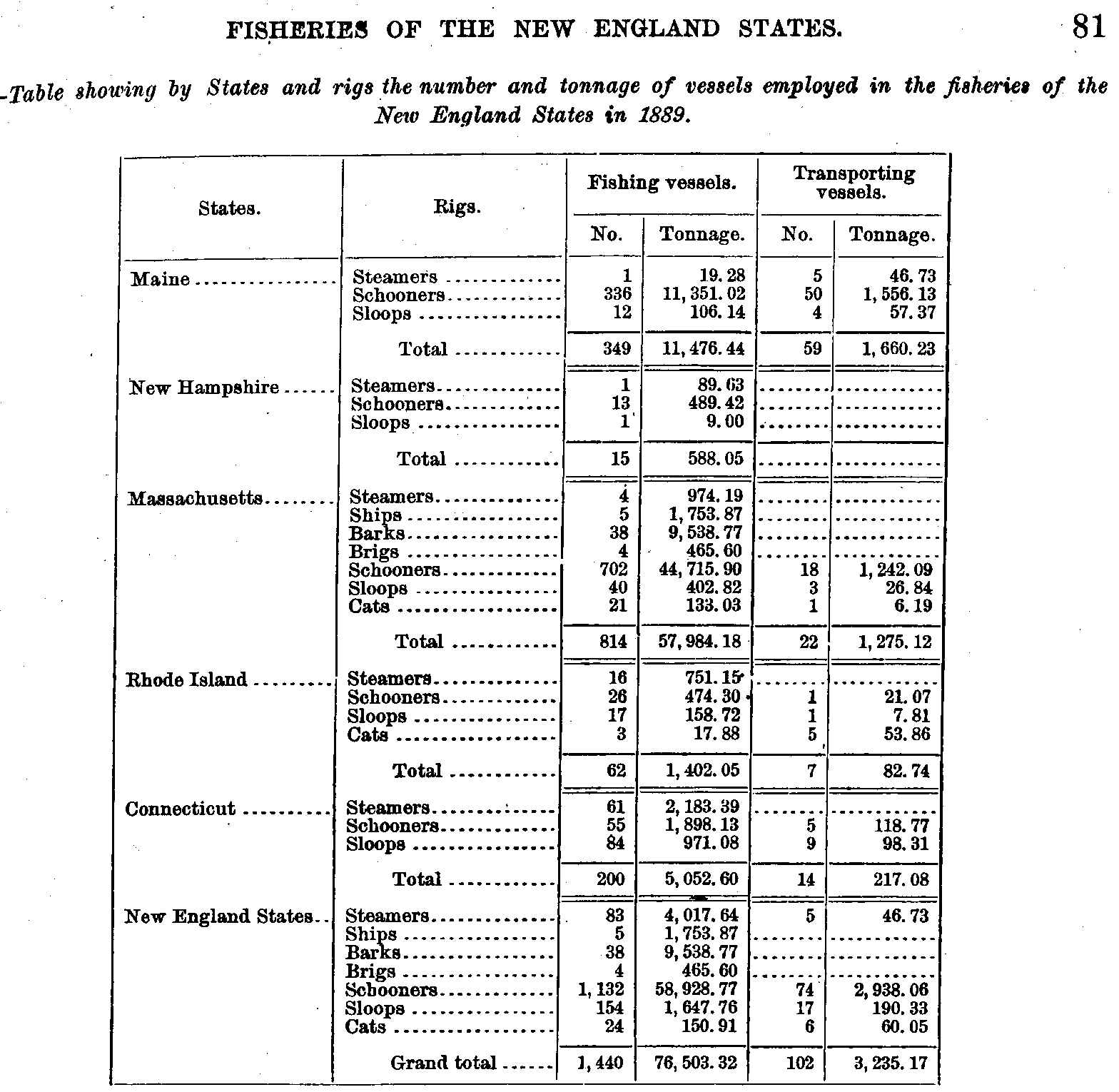
A further classification of the products of the fisheries is given in the following tabulation. The various fisheries for food-fish are seen to have yielded $6,570,610, the fisheries for oysters, clams, and other mollusks, $1,907,811; the fisheries for lobsters, crabs, and other crustaceans, $837,301; the fishery for menhaden, $395,167; and the fisheries for whales and seals, $837,073.
Table 6 showing the values of the various coast fisheries of the New England States in 1889.

-------------------------------------------------------------------------------------------